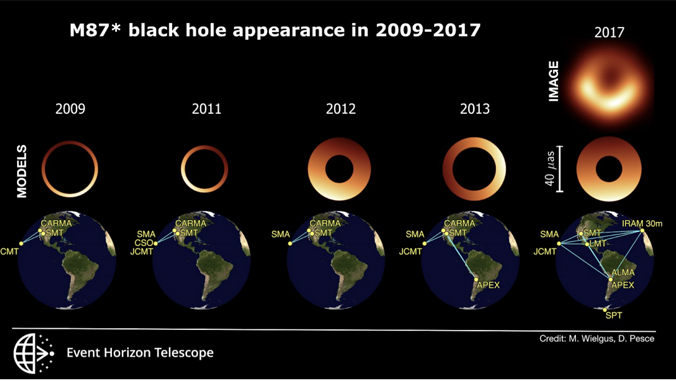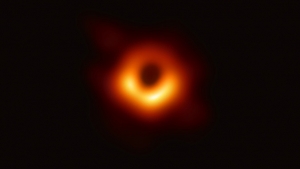
A new study highlights the integral role telescopes on Maunakea played in revealing how Pōwehi, the supermassive black hole, moves. New analysis of data taken 2009–2013 by the James Clerk Maxwell Telescope (JCMT) and the Submillimeter Array (SMA) show Pōwehi’s shadow was moving during that time frame and has continued to do so ever since.
Pōwehi made international news in 2019 after becoming the world’s very first image of a black hole. JCMT and SMA played a vital role in capturing the image and Larry Kimura, a Univesity of Hawaiʻi at Hilo Hawaiian language professor, collaborated with astronomers on the Hawaiian name. Pōwehi means embellished dark source of unending creation and comes from the Kumulipo, the primordial chant describing the creation of the Hawaiian universe.
- Related UH News story: Makaola: New Hawaiian word created to mark signs of life on Venus, September 15, 2020

Analysis reveals the persistence of the crescent-like shadow feature of Pōwehi, but also variation of its orientation—the crescent-like shadow appears to wobble. The observations were taken for the Event Horizon Telescope (EHT), a global network of synchronized radio observatories that work to observe sources associated with black holes.
“The most important thing that we have learned is that the shadow of Pōwehi is always there. That means it is real and is caused by the light bending from the black hole,” said EHT Project Scientist at Academia Sinica Institute of Astronomy and Astrophysics Geoff Bower. “The wobble tells us about how gas is flowing around the black hole, varying like clouds in the sky or waves on the ocean. What’s next is to use our improved array and make images over years to come and learn from those changes to answer questions like, ‘How does Pōwehi feed itself?’”
The study was published in The Astrophysical Journal and finds the new result is possible due to scientific advances made by the Maunakea-based telescopes. Gas falling onto a black hole heats up to billions of degrees, ionizes and becomes turbulent in the presence of magnetic fields. This turbulence is what causes the appearance of black holes to vary over time.
Prior experiments were critical to learning more about the famed black hole. When JCMT and SMA produced the world’s very first image of a black hole in 2019, scientists relied on theory and believed that Pōwehi’s shadow was changing over time. But the 2019 image alone provided just a week-long snapshot into its life, too short of a timeframe to see those changes or understand them.
- Related UH News stories:
- Maunakea telescopes win the ‘Oscars of Science’ for Pōwehi, September 6, 2019
- Are black holes made of dark energy?, September 9, 2019
Advancements on Maunakea will be ready in time for the next EHT observations of Pōwehi in 2021. JCMT will use a new, more sensitive instrument, Nāmakanui (Big Eyes). The three-camera instrument was also named by Kimura to reference red-colored, big-eyed species of nocturnal fish: ʻŪʻū, ʻĀweoweo and ʻAlaʻihi.
“It is rewarding for our Hawaiʻi staff to see the depth and breadth of new science being mined from a decade of observations,” said Jessica Dempsey, deputy director of the East Asian Observatory and JCMT. “It’s like we started the sketch ten years ago, and now with new tools and experience, our science teams are going back and able to not just fill in the color in the image, but make that image come to life.”

